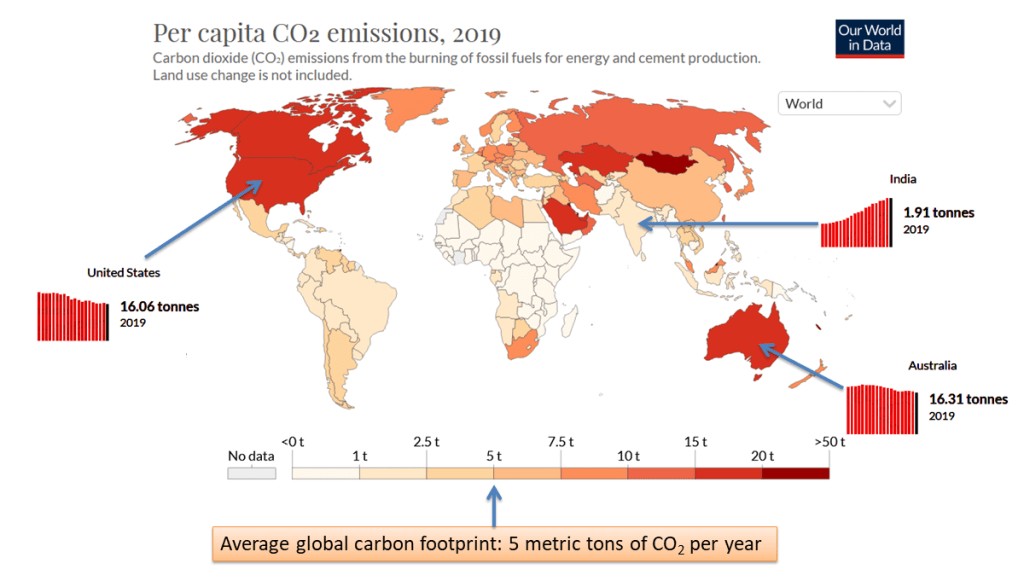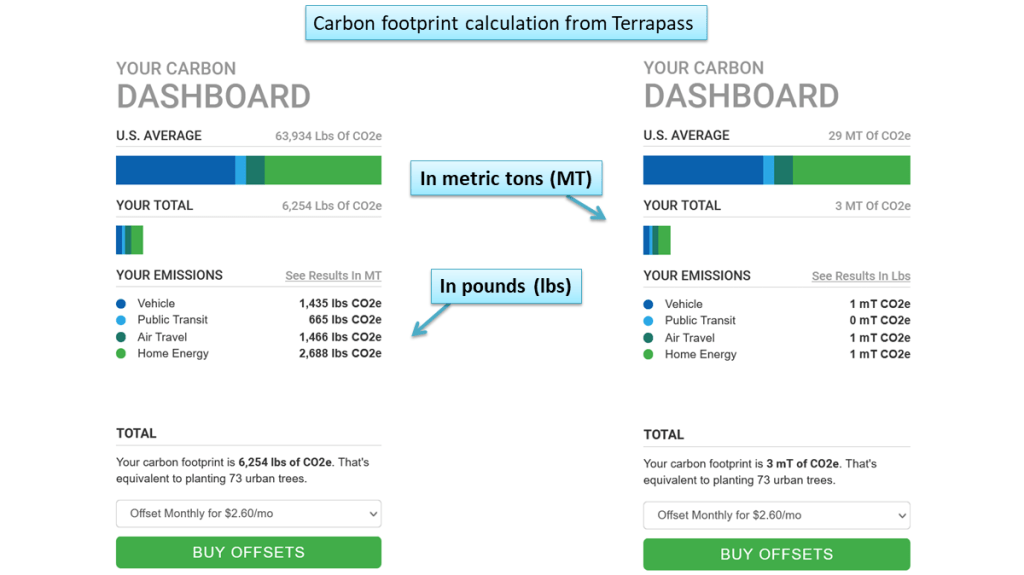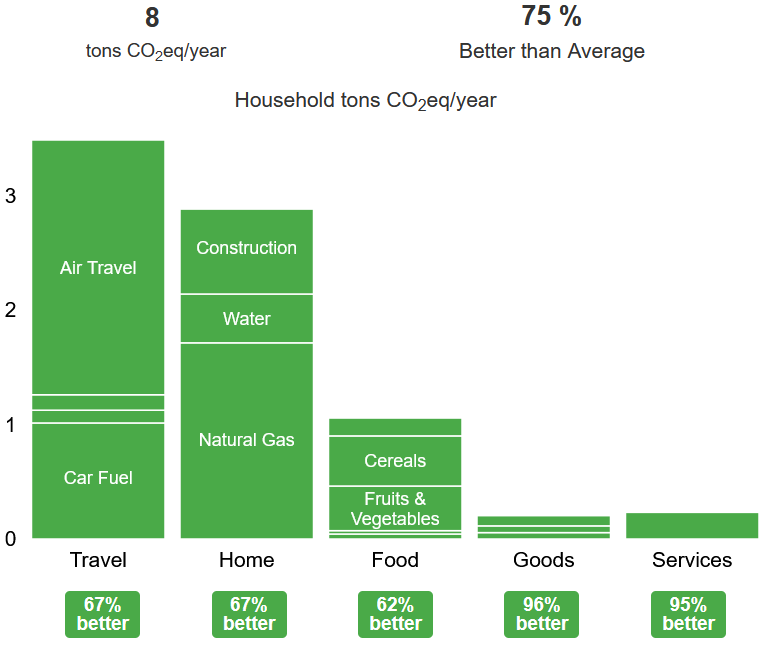Since summarizing the latest report from the Intergovernmental Panel on Climate Change (IPCC), I’ve been researching the process of calculating and offsetting my individual carbon footprint. I guess what also prompted it was that I had to book a flight (first one in over two years!) and was offered to offset the carbon footprint after purchasing the flight. I was surprised at how little it cost – about $11 to offset the 1.1 tonnes of CO2 generated by 10,000 miles of flying (US to Europe, return). I was then curious to find out two things:
- What’s my total carbon footprint?
- Is it effective to pay for carbon offsetting?
First, I want to put it in context with a reminder and breakdown of the IPPC climate target and global “carbon budget.”
IPCC CO2 emissions budget
The total carbon budget (i.e., the amount of CO2 emissions allowed) that would give us a 50% chance of meeting the Paris Agreement’s goal of staying below 1.5°C global warming is 500 Gt CO2 (Gt = gigatonne = 1 billion metric tonnes of CO2). See the previous post on the IPPC 2021 climate change report for more numbers on this.
That CO2 budget accounting started at the beginning of 2020 and global emissions are around 40 Gt CO2 per year. So, by the end of 2021 we’ll have emitted around 80 Gt CO2 – almost one sixth of that 500 Gt CO2 budget.
It’s a bit easier to think about this amount of CO2 if divided among the human population. There are around 7.8 billion people on earth, and the average carbon footprint is around 5 tonnes CO2 per person per year. This map lets you check the average carbon footprint per capita in each country – as expected, it correlates with wealth. In India, the average carbon footprint is around 2 tonnes CO2 per year (and rising) while it’s closer to 16 tonnes in the US, Canada, Saudi Arabia, and Australia.

Predictably, the US comprises only 4% of the global population and yet generates 17% of global CO2 emissions, per capita. What a bunch of wankers! So, err… being one of those resident wankers, I figure it’s time to measure my own carbon footprint.
What’s my total carbon footprint?
That return flight across the Atlantic was calculated by Conservation International to have a carbon footprint of 1.1 tonnes of CO2. That’s the organization that I used to offset that carbon footprint, for around $11 (just 2% of the cost of the flight) – more on that later.
Looking beyond that flight, I used Terrapass to calculate my carbon footprint for travel and home energy. Here are the inputs:
- Driving 2000 miles per year in my car
- 50 miles of travel by train per week
- 5000 miles of air travel per year (that’s optimistic but does reflect the last few years)
- $25 per month spent on natural gas at home.
- My electricity from East Bay Community Energy is carbon neutral (of course I still try to conserve it).
You can see the output below. Annoyingly, it rounds the results in metric tonnes (MT) to whole units – the public transit would read 0.3 metric tonnes instead of zero. So I’m showing the results in lbs as well as in MT.
My calculated carbon footprint is 3 metric tonnes per year. I don’t know why Terrapass lists the US average as 29 tonnes of CO2 (instead of around 16 tonnes) but perhaps the number is based on actual Terrapass users rather than the average person. Before I start celebrating my apparently low footprint, I should point out that this doesn’t include everything. It doesn’t touch on food, building materials, and general stuff.
For a more complete carbon footprint calculation, I turned to CoolClimate at UC Berkeley.
Calculating my carbon footprint using CoolClimate
This site is more comprehensive in that I was allowed to input info on my diet and goods and services purchased. My total is 8 tonnes of CO2 per year – considerably higher than the number calculated by Terrapass. I’m glad I didn’t celebrate prematurely.
I think I can knock off 1 tonne of CO2 that’s labeled as “construction” (see the image, below) – this number is generated based on what the average person (in an apartment my size) spends on home construction projects. It greatly overestimates my level of activity – I’ve spent approximately zero on construction, furniture, etc., over the last decade, lol. It is worth pointing out that constructing a new home (especially from steel and concrete) carries a very large carbon footprint.
Top tip: being lazy and cheap greatly reduces your carbon footprint.
I kept all of the other inputs the same as on Terrapass (2000 miles of driving, 5000 miles of flying) but CoolClimate calculates my air travel at 2.2 metric tonnes of CO2. That’s twice the footprint of the other sites, above. My guess is that this it’s including the other impacts of air travel beyond burning jet fuel. If you take a look at the last image in my IPCC climate change report summary, you’ll see that the climate impact of air travel includes contrails and stratospheric water emissions. In fact, over a 10-year time frame these factors are bigger than the CO2 emissions.
According to CoolClimate’s Twitter page, it’s the only carbon calculators backed by peer-reviewed research.
So, if I remove the footprint for construction (n/a for me) I think my total carbon footprint is somewhere around 7 tonnes of CO2. Probably the most interesting thing from all of this is that my CO2 emissions from natural gas are higher than I would have expected. I tend to take pretty long showers, so I think I can significantly reduce my carbon footprint by reducing my hot water usage at home.
Obviously, flying as little as possible helps a great deal too – when I do fly, I’m planning to make each trip count by staying as long as possible (and hence take fewer trips). Honestly, I think the idea of flying a long distance to spend 5 nights somewhere is pretty lame anyway.
My diet is always vegetarian and has been increasingly vegan since lockdown started, so my plan is to just maintain that – and I’ll also be reporting on my favorite plant-based food here as well as on Ethical Bargains.
I looked into a few other carbon footprint calculators and my feeling is that CoolClimate is the most useful way to calculate your carbon footprint as it includes food and goods purchased. It also calculates the footprint of air travel more accurately, I believe. We’ve been dealing with climate change for decades now, and there’s really no excuse for lazy accounting.
Should I offset my carbon footprint?
I could offset my seven-tonne carbon footprint for around $5 per month – is this worthwhile?
The general consensus is that the most important thing is to focus on minimizing your carbon footprint (and material footprint, for that matter). Offsetting your footprint is not a bad idea, as long as you keep in mind that it’s not a perfect solution to our climate change problem. Here are a few quotes from and links to a few of the best articles that I read on the topic of offsetting your carbon footprint.
If you offset to assuage guilt and to make yourself feel better about high-carbon activities such as flying, that can’t be good. If you offset as part of cutting your footprint, or as an incentive to be greener (after all, the less you emit, the less it will cost you to go carbon neutral) then that can’t be bad – especially if the offset projects offer extra benefits such as poverty reduction in the developing world. – A complete guide to carbon offsetting, from The Guardian
If you want to buy official offsets, we recommend giving to Gold Standard-approved wind or solar energy projects. You can find Gold Standard VER projects on the Gold Standard website and you can buy Gold Standard CERs directly through the UN’s platform. – A short guide to carbon offsets, from Ethical Consumer
You should always take promised emission cuts with a pinch of salt, bearing in mind that independent research has cast doubt on them, even in the case of the most reputable standards. The best thing to do is reduce your own emissions in the first place. – A short guide to carbon offsets, from Ethical Consumer
To protect your wallet, you can buy offsets that have been authenticated by third-party certification programs, such as Verified Carbon Standard, Gold Standard, and Green-e Climate Standard. Those programs help confirm that projects actually exist and that you’re not wasting your money. – Are carbon offsets a scam?, from Yale Climate Connections
The offset seller should make several guarantees in this transaction. First, that the offsets are real. Relatedly, the offset should be verified and enforceable. The offset should also be permanent. Finally, the offset must be additional. This is the trickiest issue with carbon offsets. – Should you buy carbon offsets?, from the NDRC.
Many people are confused by the low prices of carbon offsets. If it’s so bad for the environment to fly, can a few pounds really be enough to counteract the impact? The answer is that, at present, there are all kinds of ways to reduce emissions very inexpensively. After all, a single low-energy lightbulb, available for just £1 or so, can over the space of six years save 250kg of CO2 – equivalent to a short flight. That’s not to say that offsetting is necessarily valid, or that plugging in a low-energy lightbulb makes up for flying. The point is simply that the world is full of inexpensive ways to reduce emissions. – A complete guide to carbon offsetting, from The Guardian
Bottom line: Yes, I think that offsetting your carbon footprint (via a reputable non-profit, as discussed above) is useful. I think the most important thing to do is to look at your carbon footprint using a good calculator such as CoolClimate.




Calculating and offsetting your carbon footprint is an excellent idea. Thank you 😊
LikeLike
Thanks Asitha. I’m enjoying your climate posts too!
LikeLike
You are welcome! 😊
LikeLike
This is very informative. I don’t know what else to do to lessen my carbon footprint, short of being a hermit living in a cave. We don’t even turn on the heater ( we live in Ca) during winter ( we just layer up ) , or turn on the airconditioner in 110F heat.
LikeLike
Adopting a plant-based diet as much as possible. Flying and driving as little as possible 🙂
LikeLike
I calculated my carbon footprint as being 11 tonne per year. Higher than expected, but this was primarily down to having a car and kids.
LikeLike
Good to know, Elaine. Was this using the CoolClimate calculator?
LikeLike
This is really helpful. I’m flying back to Old Blighty end of Sept so will look into offsetting as well as seeing what Cool Climate has to say about how destructive I am. I try but can always do better. Thanks again for your hard work and number crunching which I’m rubbish at.
LikeLike
Thank you Frances! Make sure to give BoJo a hard time when you get there, now that you’re a citizen! And congrats again 🙂
LikeLike
Thanks again, James. And I will do… now that I can vote. LOL
LikeLike
I calculated my carbon footprint a few years ago using the Global Footprint calculator (https://www.footprintcalculator.org/home/en), which I liked because it gave my personal Overshoot day. I’ll have to try out the ones you’ve linked to (and retake the one I’ve used before because I haven’t been going very far since the pandemic!)
LikeLike
Interesting. I just tried it and got June 17 as my overshoot day.
The carbon footprint was 6.4 tonnes, which is fairly similar to the Cool Climate calculator.
Thanks for sharing that!
J
LikeLike